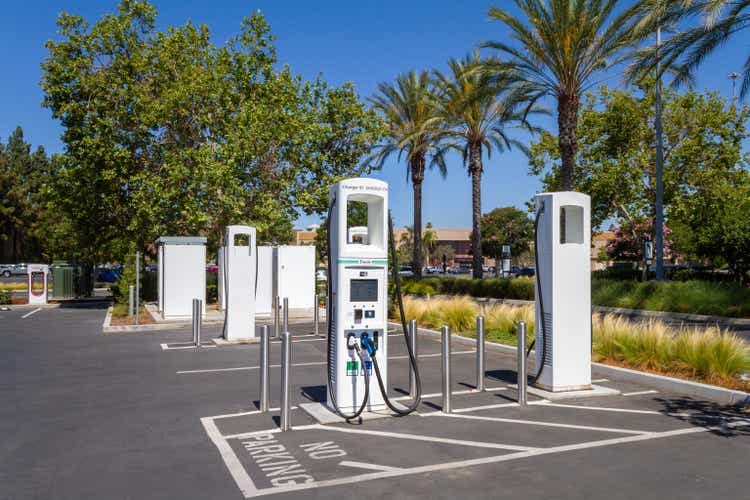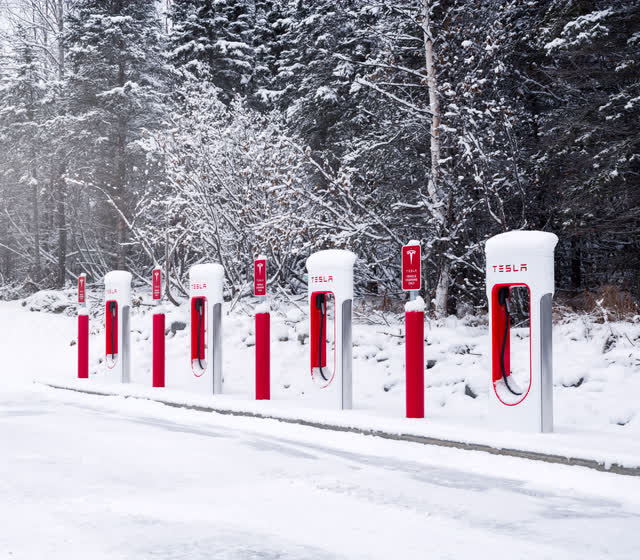Electrify America charging station at the Brea Mall in the Orange County sanfel/iStock Editorial via Getty Images
The popularity of Tesla (TSLA) and growing pressure from regulators in the U.S. to eliminate carbon dioxide emissions from automobiles has resulted in a wave of new BEV models from General Motors Co. (GM), Ford Motor Co. (F), Hyundai Motor Co. (OTCPK:HYMLF) and other automakers, including small startups.
BEVs are a new class of vehicle, which run on electric power only, provided usually by a large rechargeable lithium-ion battery. The driving range provided by a single charge often falls between 200 and 300 miles, meaning that a motorist must have access to a charger, either at home or at a publicly-available location.
What, me worry?
Much has been written and debated about so-called “range anxiety,” the worry that a vehicle will run out of charge and grind to a stop before the driver can find a charging location. I decided to learn more about this phenomenon last weekend while driving a 2023 Genesis GV60, equipped with a 77.4-kilowatt hour lithium-ion battery, from Detroit to Pittsburgh and back, relying on public charging stations between the two cities to refuel.
The good news: I made it! The not-so-good news: Public recharging facilities on a relatively well-traveled route between two major U.S. cities still leave much to be desired. To the extent that my experience with the inter-city charging infrastructure is typical, I wouldn’t recommend purchase of a BEV until improvements are made. (As for local use near a home-charging port, BEVs could be ideal – more on that later.)
I departed my home in Bloomfield Hills, Michigan, early on Friday, with about 150 miles of range indicated on the control panel. Relying on recommendations, I downloaded several apps from several different recharging companies that have sprung up to construct stations at various locations. The first location, at a supermarket just north of Toledo, provided chargers that only worked with Teslas. (My bad. I failed to notice on the recharger location app that the station was Tesla only.)
A defect of the current state of charging is the lack of a single standard. Three standards exist, including Tesla’s, which is two too many.
Tesla, perhaps wisely, has constructed a proprietary nationwide charging network. The automaker claims to have 35,000 recharging units nationwide at more than 1,500 stations. Tesla recently offered its design to other manufacturers and automakers willing to switch so as to facilitate adoption of a single recharging standard – so far, no takers.
Shattered expectations
Having failed on my first refueling try, I drove another 23 miles to an Electrify America recharging station located at the Wyandot rest stop on the Ohio Turnpike. By now I had driven 90 miles from my home, the distance on the display showing about 40 miles of range left. The vehicle should have registered about 60 miles. I was learning that range can easily degrade from the expected number due to high or low temperature, change in elevation and driving habits, such as traveling at a high rate of speed.
The Electrify America charger at Wyandot refused to accept my Visa card and then refused my American Express card. The company’s helpful representative, reached via toll-free number, suggested I try Apple Wallet, which worked on the second try, enabling me to recharge the Genesis’ battery – but only to 80% of the 235-mile recommended maximum or about 188 miles – insufficient to reach Pittsburgh, 212 miles away.
I should add that during the recharge, a chilling rain fell. The chargers, unlike the gasoline pumps, aren’t covered. Cold and wet, I resumed my journey. As I approached Pittsburgh with 60 miles or so left on the battery’s range, I fired up my Electrify America app’s search function, which suggested a charging station near Youngstown, Ohio, and off my intended route. Nevertheless, I proceeded to the station and was relieved when the charger accepted payment, allowing me to refuel.
Because of the weather, the route changes and the recharging stops, which take at least half an hour or longer depending on the rate of the charger, the normal five-hour road trip between the two cities took close to eight hours.
The following day, having “spent” some of my mileage in Pittsburgh, I headed back to Detroit. Using the Blink charging app, I detoured to a station near Zelienople, Pa., – off the turnpike. Unfortunately, the single working charger was occupied by another car. On to an Electrify America station in Cranberry Township, north of Pittsburgh. I guess because Saturday can be a convenient time to charge a BEV, all the chargers were occupied.
While waiting for one of the four BEVs to finish charging, a flatbed trailer arrived with an Audi e-Tron, the flustered driver reporting that she ran out electrons a few miles before reaching the station. Evidently, the mileage function on her Audi’s instrument panel failed to account for the change in elevation during her trip, which depleted her vehicle’s range faster than expected.
Chill in the air
With temperatures dropping to below 40 degrees, I decided to conserve range by turning off the cabin heater in the Genesis. Fortunately, the seat heater – which didn’t seem to affect range – kept me reasonably warm.
After one more charging stop in Sheffield Crossing, Ohio, I finally returned home. The usual five-hour trip from Pittsburgh had taken nine hours.
Were someone to ask me if he or she should buy a BEV, I would respond that the vehicle type probably isn’t ideal for road trips, even occasional ones. The best BEV use case would be for a person who owns a second gasoline vehicle and who also owns an enclosed garage, and who’s willing to spend about $1,000 for a Level 2 charger (slower than a DC fast charger) that can keep the vehicle topped up overnight for short and medium-range trips close to home.
My $75,000 Genesis GV60 handled well, was loaded with premium convenience and safety features, and looked extremely attractive. That said, it’s possible to buy BEVs that cost considerably less.
Automakers such as GM and Ford are pouring tens of billions of dollars into battery manufacture and new BEV models under the assumption that this type of technology will reach mainstream buyers in the next few years. Toyota Motor Corp. (TM) is notable for its more nuanced strategy to offer BEV models more slowly than GM and Ford, while continuing to invest in gas-electric hybrids and gasoline models.
In my opinion, the migration to BEVs could take years longer than some of the automakers forecast, because the gasoline infrastructure – developed over a century – works pretty well. The speed of the BEV rollout will depend on continued improvements in the charging infrastructure and batteries, consumer willingness to try new and somewhat less convenient technology, and – of course – government action designed to incentivize BEVs and discourage the use of fossil fuels.



Be the first to comment